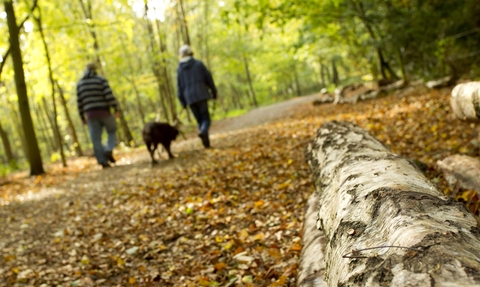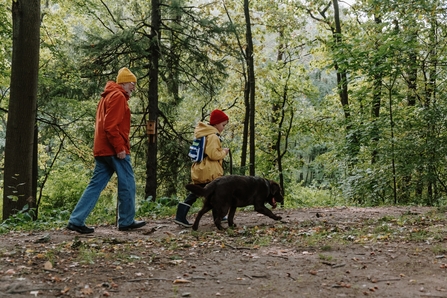
Ben Hall/2020VISION
Visiting our Nature Reserves with dogs
Our reserves are all managed principally for wildlife. We aim to create wildlife havens – tailored habitats where wildlife can flourish away from the pressures of human activity. Walking through our reserves, observing the wildlife and enjoying the great outdoors needn’t adversely affect the reserve’s wildlife. In fact, we believe the more people experience and appreciate nature, the more likely they are to support its conservation.
Visiting a nature reserve with your dog can potentially cause problems for wildlife, however, and we have therefore designated each of our Nature Reserves as either dogs welcome; dogs on leads welcome or no dogs.
Please read the information below to understand further why we ask this and many thanks for your understanding and cooperation.

Peter Cairns/2020VISION
Please respect signage which asks for no dogs, dogs on leads or to stay on marked paths
Dogs are viewed as predators by many species. Even if not chasing wildlife, a dog’s presence will disturb many birds and mammals. Otters and ground nesting birds such as curlew will rarely take up residence in a site frequented by dogs. If disturbed by the presence of dogs, ground nesting birds will often abandon eggs and not return again to nest at the site. This includes species in decline such as skylark, grey partridge and yellow wagtail.
Even a well-trained dog can instinctively chase, and in some cases injure or kill, wildlife or grazing livestock. Such dogs are not being ‘bad,’ it is just their natural instinct. When incidents do occur, nearly all owners comment that their dog has never done anything like this before. There can always be a first time. Keeping them on a lead will prevent such accidents. Where populations are particularly vulnerable, we may not allow dogs onto a site.
Other visitors to the reserve may not be comfortable around dogs. We want everyone to be able to enjoy visiting our reserves but some visitors, especially small children, can be nervous around dogs which can spoil their visit.
Tenant graziers often graze livestock on our reserves as part of our conservation grazing schemes and reserves are also often situated alongside livestock pasture. Agitated livestock can be dangerous for both dogs and people. Please be aware that farmers can legally shoot dogs which they believe to be worrying their livestock. Please don’t put your dog or yourself at risk.
Some of our reserves are home to rare or sensitive flora – for example the snake’s head fritillaries on Lugg Meadow SSSI. While these are, of course, wild plants, we do ask that such species are kept safe from both feet and paws where possible to give them the best chance to thrive.

Please pick up all dog mess left by your dog
Dog mess can be at best unpleasant and at worst hazardous to wildlife, livestock, visitors volunteers and staff working on the reserve. Particularly unpleasant is the unexpected encountering of dog mess with a strimmer. Dog faeces can carry the toxicara parasite which causes an infection in humans as well as the eggs of neospora, a parasite which can spread to cattle and causes miscarriages and infertility.
As dogs are carnivorous, their waste can also negatively impact soil quality on some reserves that are frequently used by dog walkers. Particular sites have a delicately balanced nutrient content and ph, which if disrupted by dog mess can affect the important flora growing there.
Many of our sites are cut for hay as part of their conservation management. Dog mess in hay is unpleasant and dangerous for those handling it and for the livestock the hay is fed to. When hay from certain sites regularly contains dog mess, farmers will not accept the hay. This is a particular problem on Lugg Meadow and may affect our income from hay sales.
Increasingly, dog owners leave dog mess in bags around reserves, sometimes hung on fences or branches. This is no less unpleasant to encounter, can be equally hazardous, and additionally incurs costs through the time spent clearing and disposing of these bags which would otherwise be spent on constructive habitat management.
Very few of our reserves are ‘open access’ sites. We own and manage the sites for wildlife and invite the public to visit them only in accordance with the above advice.
We are grateful for your understanding and cooperation.
